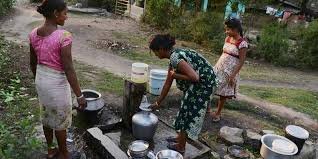New Delhi-Since the launch of the Jal Jeevan Mission (JJM) in August 2019, India has made significant strides in improving access to safe and clean drinking water in rural areas. This flagship initiative, known as ‘Har Ghar Jal’, aims to ensure the supply of potable tap water in adequate quantity and of prescribed quality to every rural household on a regular and long-term basis. The mission is a collaborative effort between the central and state governments, with states holding primary responsibility for planning, implementation, and maintenance of water supply schemes.
One of the pressing challenges addressed under this mission is the presence of chemical contaminants like fluoride in drinking water. Fluoride contamination, known to cause serious health conditions like fluorosis, has been a long-standing concern in many parts of the country. Under JJM, the Bureau of Indian Standards’ BIS:10500 norms are used to ensure water quality. The government has prioritized fluoride-affected areas and encouraged states and Union Territories to develop piped water supply systems using safe alternative water sources.
A noteworthy achievement of the mission is the marked reduction in the number of fluoride-affected rural habitations over the years. On April 1, 2019, there were 7,996 such habitations. By July 23, 2025, this number has been brought down drastically to just 248. This reflects a focused and effective implementation of the water supply schemes with improved quality monitoring and intervention strategies.
For areas where piped water infrastructure is yet to be completed, the government has ensured interim solutions through the installation of Community Water Purification Plants (CWPPs) and Individual Household Purifiers (IHPs). These provide 8 to 10 litres of fluoride-free drinking and cooking water per person per day. As of July 2025, all 248 remaining fluoride-affected habitations have been provided with such purification facilities, ensuring that no rural habitation is left without access to safe drinking water.
State-wise, Punjab leads with 119 fluoride-affected rural habitations fully covered with purification units, followed by Rajasthan with 78, West Bengal with 37, and Odisha with 14. All these habitations have received adequate infrastructure support to eliminate the risk of fluoride consumption.
Parallel to this, the Government of India is also tackling fluorosis through the National Programme for Prevention and Control of Fluorosis (NPPCF). This health initiative, currently active in 163 districts across 19 States and UTs, focuses on strengthening medical infrastructure, including the appointment of specialized personnel, equipping laboratories for water and urine fluoride analysis, providing medical training, and running health education campaigns. The programme also supports vitamin and mineral supplementation and, where needed, medical treatment including reconstructive surgeries and rehabilitation services.
While fluoride-specific funds are not separately allocated under JJM, states have utilized the broader financial framework of the mission effectively. Since 2019-20, the central government has allocated and released substantial funds for the provision of potable tap water. The total expenditure has steadily increased with Rs. 5,983.49 crore spent in 2019-20, rising to over Rs. 82,295.58 crore in 2023-24. In the current financial year of 2025-26, expenditure reported so far is Rs. 7.59 crore from the central share and Rs. 3,063.52 crore from the states.
The data suggests not only a well-coordinated national effort to eliminate fluoride from drinking water but also a strong public health commitment to mitigate its long-term effects. With fluoride contamination on the decline and infrastructure rapidly improving, the Jal Jeevan Mission is paving the way for a healthier and safer rural India.
This information was provided by The Minister of State for Jal Shakti V. Somanna in a written reply to a question in Rajya Sabha today.






